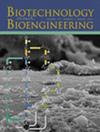基于细胞穿透肽的三重纳米复合物使莱茵衣藻的核基因高效传递
IF 3.5
2区 生物学
Q2 BIOTECHNOLOGY & APPLIED MICROBIOLOGY
引用次数: 0
摘要
微藻具有捕获温室气体和生产可再生材料的能力,因此有望成为缓解气候变化的解决方案。然而,它们的有效应用经常受到障碍的阻碍,这些障碍需要基因工程的进步来提高光合作用和生产力。一个主要的障碍是微藻细胞壁,这使遗传物质进入这些生物变得复杂。为了解决这些挑战,我们开发了一种新的三重纳米复合物系统,将细胞穿透肽(CPPs)、核定位信号(NLS)肽和质粒DNA整合在一起。该系统允许简单的制备,同时实现质粒DNA的高效核易位。我们评估了两种CPPs, pVEC‐ORI和pVEC‐R6A在促进DNA向野生型莱茵衣单胞菌细胞内转移的功效。值得注意的是,尽管存在较厚的细胞壁,但pVEC - R6A的效率比pVEC - ORI提高了6.88倍。pVEC‐ORI和pVEC‐R6A的最佳CPP:DNA比分别为5:1和10:1。通过将猴病毒40 (SV40) NLS整合到CPP/DNA纳米复合物中,我们成功地将质粒DNA定位到细胞核中。我们的研究结果表明,这种简单高效的DNA传递系统作为一种推进微藻合成生物学的工具具有巨大的潜力。本文章由计算机程序翻译,如有差异,请以英文原文为准。
Cell‐Penetrating Peptide‐Based Triple Nanocomplex Enables Efficient Nuclear Gene Delivery in Chlamydomonas reinhardtii
Microalgae are a promising solution for mitigating climate change due to their ability to capture greenhouse gases and produce renewable materials. However, their effective application is often hindered by barriers that necessitate advances in genetic engineering to improve photosynthesis and productivity. One major obstacle is the microalgal cell wall, which complicates the delivery of genetic material into these organisms. To address these challenges, we developed a novel triple nanocomplex system integrating cell‐penetrating peptides (CPPs), nuclear localization signal (NLS) peptides, and plasmid DNA. This system allows simple preparation while achieving efficient nuclear translocation of plasmid DNA. We evaluated two CPPs, pVEC‐ORI and pVEC‐R6A, for their efficacy in facilitating intracellular transfer of DNA into wild‐type Chlamydomonas reinhardtii cells. Notably, pVEC‐R6A demonstrated a 6.88‐fold increase in efficiency compared to pVEC‐ORI, despite the presence of thick cell walls. The optimal CPP:DNA ratio for stable nanocomplex formation was determined to be 5:1 for pVEC‐ORI and 10:1 for pVEC‐R6A. By incorporating the simian virus 40 (SV40) NLS into CPP/DNA nanocomplexes, we successfully directed the localization of plasmid DNA into the nucleus. Our findings indicate that this simple and efficient DNA delivery system has significant potential as a tool to advance microalgal synthetic biology.
求助全文
通过发布文献求助,成功后即可免费获取论文全文。
去求助
来源期刊

Biotechnology and Bioengineering
工程技术-生物工程与应用微生物
CiteScore
7.90
自引率
5.30%
发文量
280
审稿时长
2.1 months
期刊介绍:
Biotechnology & Bioengineering publishes Perspectives, Articles, Reviews, Mini-Reviews, and Communications to the Editor that embrace all aspects of biotechnology. These include:
-Enzyme systems and their applications, including enzyme reactors, purification, and applied aspects of protein engineering
-Animal-cell biotechnology, including media development
-Applied aspects of cellular physiology, metabolism, and energetics
-Biocatalysis and applied enzymology, including enzyme reactors, protein engineering, and nanobiotechnology
-Biothermodynamics
-Biofuels, including biomass and renewable resource engineering
-Biomaterials, including delivery systems and materials for tissue engineering
-Bioprocess engineering, including kinetics and modeling of biological systems, transport phenomena in bioreactors, bioreactor design, monitoring, and control
-Biosensors and instrumentation
-Computational and systems biology, including bioinformatics and genomic/proteomic studies
-Environmental biotechnology, including biofilms, algal systems, and bioremediation
-Metabolic and cellular engineering
-Plant-cell biotechnology
-Spectroscopic and other analytical techniques for biotechnological applications
-Synthetic biology
-Tissue engineering, stem-cell bioengineering, regenerative medicine, gene therapy and delivery systems
The editors will consider papers for publication based on novelty, their immediate or future impact on biotechnological processes, and their contribution to the advancement of biochemical engineering science. Submission of papers dealing with routine aspects of bioprocessing, description of established equipment, and routine applications of established methodologies (e.g., control strategies, modeling, experimental methods) is discouraged. Theoretical papers will be judged based on the novelty of the approach and their potential impact, or on their novel capability to predict and elucidate experimental observations.
 求助内容:
求助内容: 应助结果提醒方式:
应助结果提醒方式:


